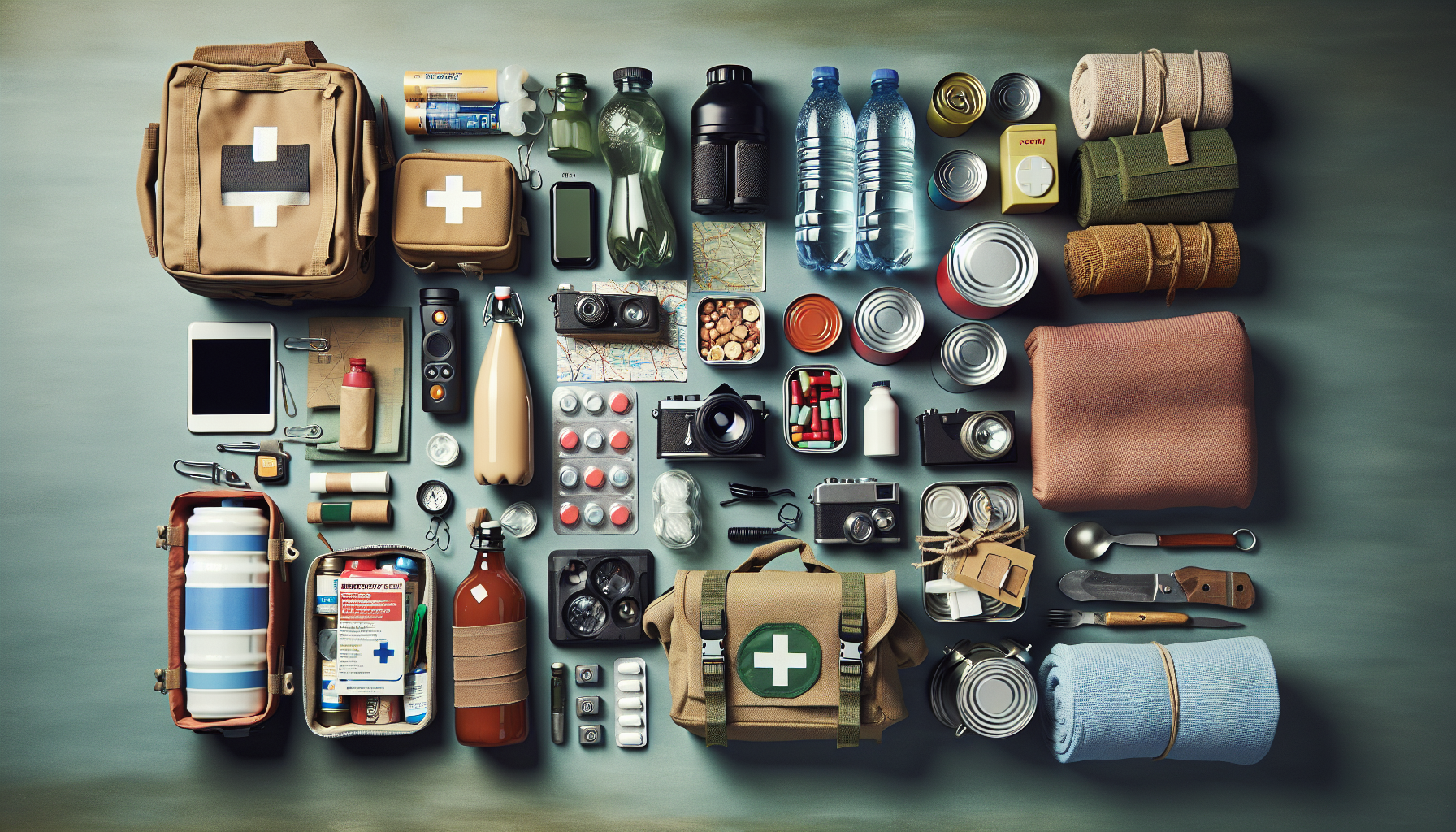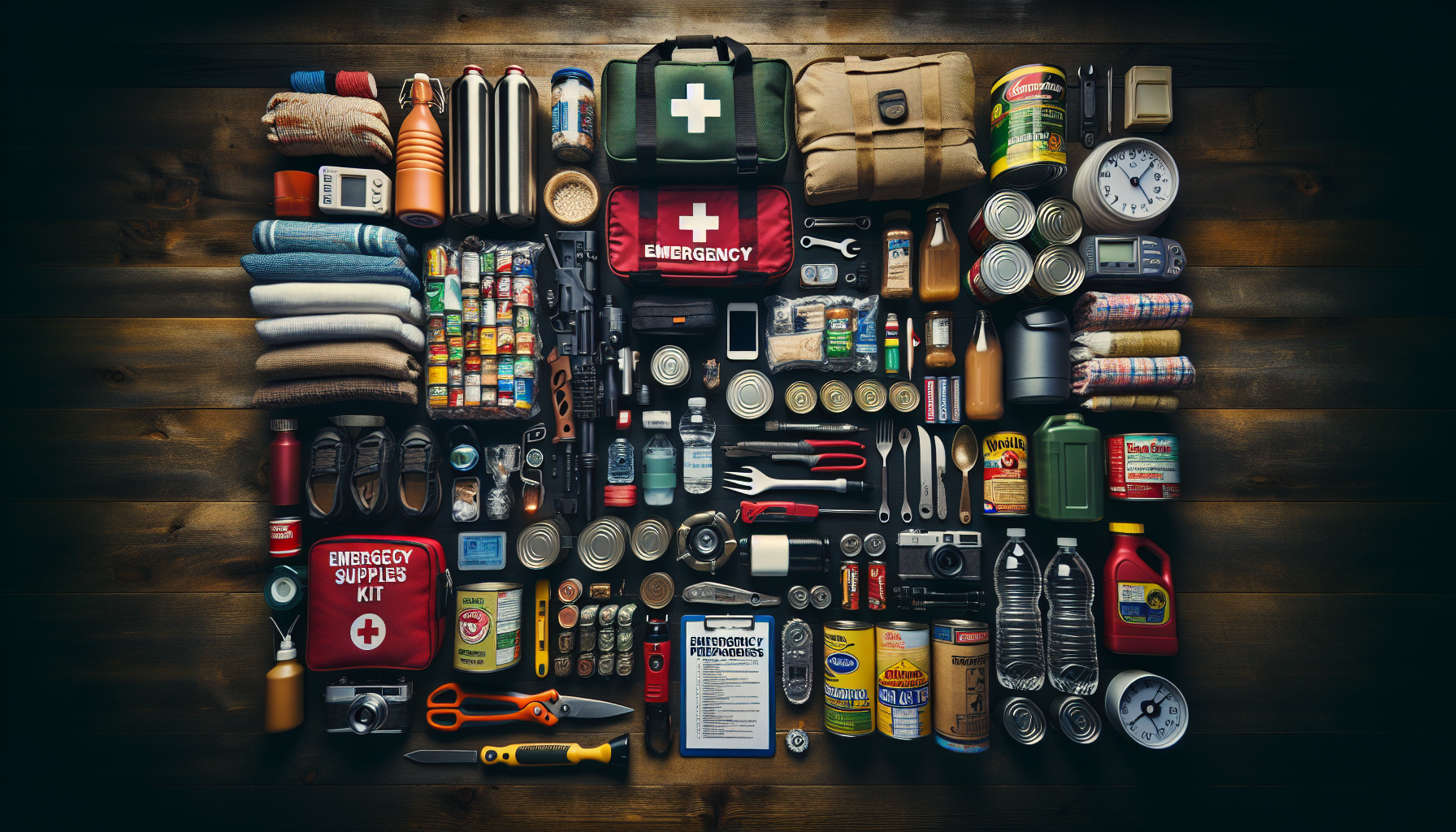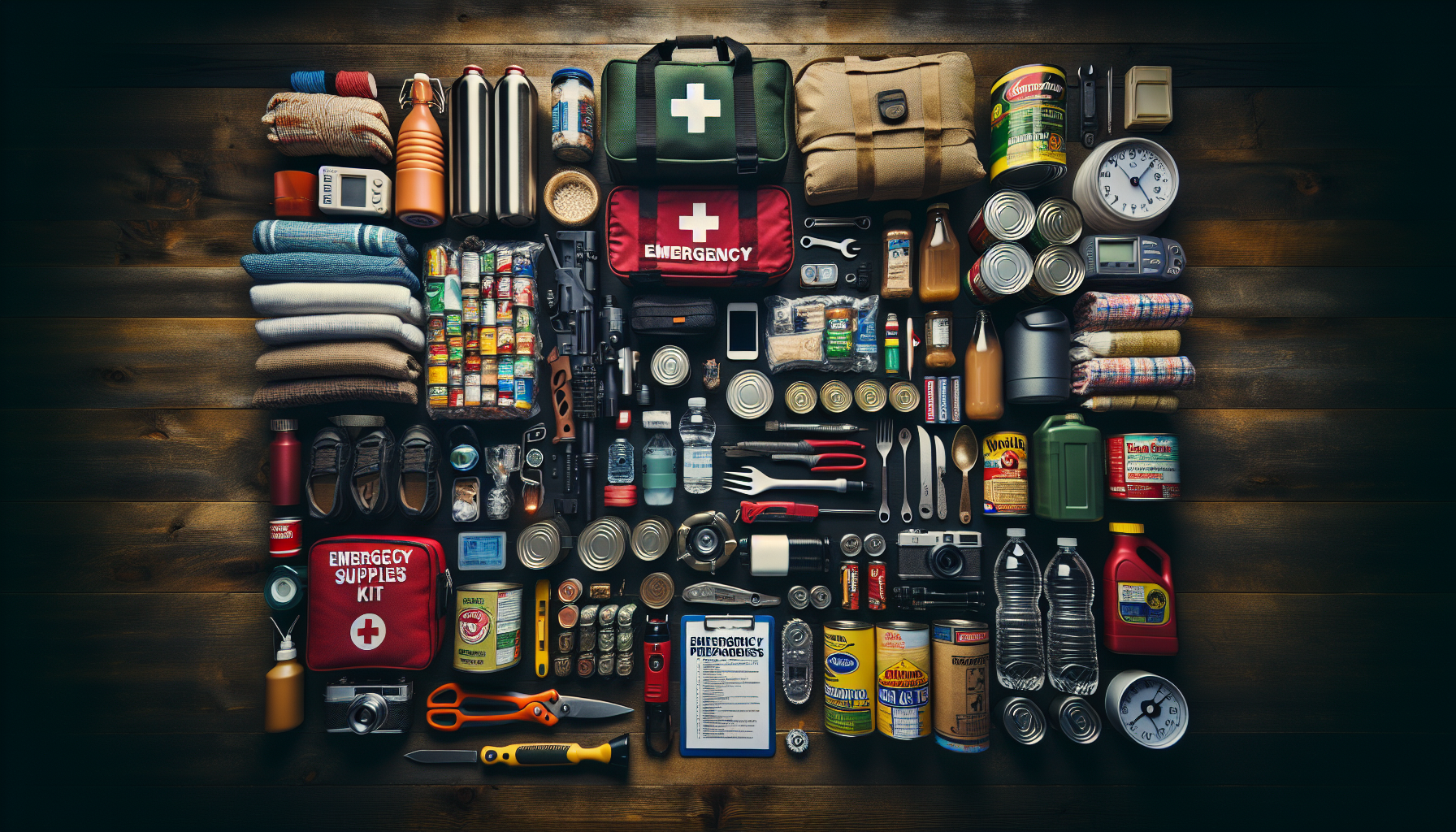In today’s unpredictable world, it is crucial to be prepared for any emergency that may arise. From natural disasters like hurricanes and earthquakes to medical emergencies or even cyber attacks, the types of emergencies we could face are diverse. It is therefore imperative to gain a comprehensive understanding of these different types of emergencies and know how to adequately prepare for each situation. In this article, we will explore the various types of emergencies one might encounter and provide insightful tips on how to be prepared, ensuring your safety and the safety of those around you.

Natural Disasters
Natural disasters can strike at any moment, and being prepared is crucial. One of the most unpredictable and destructive disasters is an earthquake. These ground-shaking events can cause widespread damage to infrastructure and pose significant risks to human life. It is essential to know how to react during an earthquake and have a well-thought-out emergency plan in place. Identifying safe spots within your home and practicing earthquake drills can help you stay calm and respond effectively when the ground starts to shake.
Another powerful and devastating natural disaster are hurricanes. These massive storms bring strong winds, heavy rain, and storm surge, which can cause catastrophic damage to coastal areas. Preparing for a hurricane involves creating an emergency kit with essential supplies such as water, non-perishable food, and first aid items. Additionally, knowing the evacuation routes in your area and having a communication plan with your family and friends is vital to ensure everyone’s safety during a hurricane.
Floods are another natural disaster that can occur both as a result of heavy rainfall or the failure of man-made structures, such as dams. Understanding flood risks in your area and taking preemptive measures, such as purchasing flood insurance and elevating your utilities, can help mitigate the impact of a flood. It is also crucial to develop a flood emergency plan, including identifying safe areas on higher ground, and ensuring you have emergency supplies stocked and ready.
Wildfires are a growing concern in many regions, particularly those prone to dry and hot weather conditions. To protect yourself and your property from wildfires, it is essential to create a defensible space by clearing out flammable vegetation and maintaining appropriate distance between structures and trees. Stay informed about wildfire risks in your area and have an evacuation plan ready, including a designated meeting point for your family in case you are separated.
Tornadoes can appear suddenly and cause severe destruction in a matter of minutes. Understanding tornado warning systems and locating safe areas in your home, such as a basement or an interior room on the lowest level, is crucial for protecting yourself during the event of a tornado. Additionally, having a weather radio, a charged mobile phone, and a supply of non-perishable food and water can help you stay prepared and informed during tornado season.
Thunderstorms, although common, can also pose risks. Lightning, strong winds, and heavy rainfall can lead to power outages, flash flooding, and even wildfires. Staying indoors during a thunderstorm and avoiding open areas or tall structures is crucial to protecting yourself from lightning strikes. It is also important to secure outdoor objects that can become projectiles in high winds and have emergency supplies on hand in case of prolonged power outages.
Volcanic eruptions, while less common, can still have devastating consequences. Being aware of volcanic activity in your area and following the instructions of local authorities can help keep you safe during an eruption. Familiarize yourself with evacuation routes and have emergency supplies ready, including face masks to protect against volcanic ash and respiratory distress. It is also crucial to stay informed about the potential for lahars (volcanic mudflows) and their associated hazards.
Man-Made Disasters
Man-made disasters can arise from various sources and manifest in different ways. Terrorist attacks, unfortunately, pose a threat in today’s world. Staying vigilant, reporting any suspicious activities, and following authorities’ instructions during a terrorist attack are crucial for personal safety. Familiarize yourself with emergency protocols in public spaces and know evacuation routes to ensure a swift and organized response in any such situation.
Chemical accidents can occur in industrial facilities or during transportation of hazardous materials. Understanding the risks associated with different chemicals and knowing how to respond in case of a chemical spill or leak is essential. Having a well-stocked emergency kit with protective equipment, such as masks and gloves, can help minimize exposure to harmful substances. It is also important to stay informed about emergency shelters and decontamination procedures in your area.
Nuclear disasters emphasize the importance of being prepared for worst-case scenarios. While the likelihood of a nuclear incident may be low, understanding the basics of radiation safety and having a plan in case of a nuclear accident is crucial. Stay informed about local nuclear power plants and familiarize yourself with evacuation routes and designated shelter locations. Having a supply of potassium iodide tablets, which can protect the thyroid gland from radiation, is also advisable if you live in a region with a high risk of nuclear emergencies.
Civil unrest can arise during times of social and political turmoil. While it is important to engage in peaceful dialogue and support positive change, it is also essential to prioritize personal safety during periods of civil unrest. Avoiding large crowds, staying informed through reliable news sources, and having a communication plan with loved ones can help you navigate such situations. Additionally, staying aware of your surroundings and making arrangements for secure transportation can contribute to your overall safety.
Industrial accidents, such as chemical spills or explosions in factories, can occur unexpectedly. Familiarize yourself with companies or industries in your area that deal with hazardous materials and know the emergency response protocols they have in place. Being prepared with personal protective equipment and having an evacuation plan ready can help keep you safe in the event of an industrial accident.
Infrastructure failures, such as bridge collapses or power grid malfunctions, highlight the importance of maintaining and regularly inspecting critical structures. While individuals may not have direct control over infrastructure failures, being informed about potential risks and having alternative routes or backup power sources can help mitigate the impact on your daily life.
Health Emergencies
Health emergencies, such as pandemics, epidemics, and outbreaks, present unique challenges to individuals and communities. Pandemics, like the recent COVID-19 pandemic, can quickly spread across borders, impacting public health and daily life. Following guidelines from health authorities, such as practicing good hygiene, wearing masks, and getting vaccinated, can help prevent the spread of contagious diseases. Stocking up on essential supplies and having a healthcare plan in place can also contribute to personal preparedness during a pandemic.
Epidemics refer to the occurrence of cases of a particular disease in excess of what is normally expected in a community or region. Similar to pandemics, practicing good hygiene, staying informed about the disease, and seeking medical help when necessary are crucial during an epidemic. Understanding the symptoms and transmission methods of the specific disease can help you take appropriate preventive measures.
Outbreaks, often localized and limited in scope, can still pose significant risks to public health. Staying informed about outbreak alerts in your area and following guidelines from health authorities can help you protect yourself and others. Ensuring you have a first aid kit at home, knowing basic first aid practices, and being prepared to isolate or quarantine when necessary are important steps in responding to an outbreak.
Technological Emergencies
Technological emergencies, although not frequently discussed, can have significant impacts on daily life and infrastructure. Cyber attacks, targeting critical computer systems, can disrupt essential services and compromise personal information. Regularly updating software, using strong passwords, and practicing safe internet habits can help protect against cyber attacks. Having alternative means of communication, such as a landline phone or a backup internet connection, can also be useful during periods of cyber disruption.
Power outages, whether due to severe weather conditions or infrastructure failures, can leave you without electricity for an extended period. Having emergency supplies on hand, such as flashlights, batteries, and non-perishable food, can help you navigate power outages. It is also advisable to have a communication plan with your family and neighbors and know the location of local emergency shelters or community centers that may provide assistance during prolonged outages.
Communications failures, including disruptions to phone networks or internet services, can hamper your ability to stay connected during emergencies. Having alternative communication methods, such as walkie-talkies or a designated meeting point with your family or friends, can help you stay in touch when traditional communication channels are unavailable. Additionally, staying informed through local radio broadcasts or emergency alert systems can provide crucial information during communications failures.
Transportation disruptions, such as road closures or delays, can occur due to accidents, severe weather events, or infrastructure problems. Keeping updated with local transportation news and having alternative routes or modes of transportation planned can help you navigate these disruptions. It is also important to have emergency supplies in your vehicle, including a roadside emergency kit and extra food and water, in case you get stranded during a transportation disruption.

Personal Emergencies
Personal emergencies can happen unexpectedly, and being prepared can make a significant difference in their outcome. Accidents, whether at home or outdoors, can result in injuries that require immediate attention. Having a basic first aid kit and knowing how to administer basic first aid can help stabilize a situation until professional help arrives. It is also crucial to have emergency contact numbers readily available and communicate your whereabouts with family or friends.
Medical emergencies, ranging from sudden illnesses to acute injuries, require prompt medical attention. Knowing how to recognize the signs of a medical emergency, calling emergency services, and providing necessary information can save valuable time during these critical situations. It is also advisable to have a list of any existing medical conditions, allergies, or medications you are taking, as this information can aid healthcare professionals in providing appropriate care.
Home fires are a common yet highly dangerous emergency. Installing smoke detectors on every floor of your home, regularly testing them, and replacing batteries can help provide early warning in case of a fire. Developing a fire escape plan and conducting fire drills with your family can ensure everyone knows the safest and fastest way to evacuate. It is essential to remember that in case of a fire, prioritizing personal safety and evacuating the premises is paramount.
Burglaries and home invasions can have a significant impact on your sense of security. Taking precautions such as installing security systems, using deadbolt locks, and keeping doors and windows secure can help deter potential intruders. Establishing a neighborhood watch program or staying connected with your neighbors can also contribute to a safer community environment. In the event of a break-in, knowing the appropriate steps to take, such as contacting the authorities and documenting any damages, can be vital for law enforcement investigations.
Financial Emergencies
Financial emergencies can cause significant distress, but proactive planning can mitigate their impact. Job loss, whether due to economic downturns or specific circumstances, can be a challenging situation to navigate. Having an emergency fund that covers living expenses for several months can provide a financial buffer while you seek new employment. Additionally, exploring other potential income sources, such as freelancing or part-time jobs, can help bridge the gap during periods of unemployment.
Unforeseen expenses, such as medical bills or car repairs, can arise unexpectedly and strain your finances. Establishing an emergency fund and consistently contributing to it can help alleviate the financial burden during such situations. It is also advisable to regularly review your insurance coverage, ensuring it adequately protects you against unexpected expenses.
Bankruptcy is a severe financial crisis that can have long-lasting consequences. Seeking professional financial advice when facing overwhelming debt can help you explore potential options and make informed decisions. Developing a realistic budget, prioritizing debt repayment, and considering credit counseling services can assist in regaining financial stability. Remember, reaching out for support is essential during difficult times, and there are resources available to help you navigate financial emergencies.
Environmental Emergencies
Environmental emergencies, such as pollution, climate change, and droughts, impact both human health and ecosystems. Pollution, whether from industry or everyday activities, can have detrimental effects on air and water quality. Supporting environmental regulations, reducing personal carbon footprint, and practicing responsible waste management can contribute to minimizing pollution and its associated risks. Educating yourself on local pollution issues and taking steps to address them, such as participating in community clean-up programs, can also make a positive difference.
Climate change poses significant challenges globally, with rising temperatures, sea-level rise, and extreme weather events becoming more frequent. Adapting to climate change involves promoting sustainable practices, such as reducing energy consumption, transitioning to renewable energy sources, and advocating for responsible land use planning. Being prepared for climate-related emergencies, such as heatwaves or severe storms, includes having emergency supplies, staying informed through weather alerts, and having a plan to stay cool or evacuate if necessary.
Droughts, particularly in arid regions, can severely impact agriculture, water supply, and ecosystems. Conserving water through efficient practices, such as using low-flow fixtures and minimizing outdoor water usage, can help mitigate the impact of droughts. Implementing drought-resistant landscaping and water recycling systems can also contribute to long-term water sustainability. It is essential to follow local water restrictions and stay informed about potential drought-related risks in your area.
Safety and Security Emergencies
Safety and security emergencies, including violence, kidnapping, stalking, and harassment, can cause immense fear and distress. Prioritizing personal safety and being aware of your surroundings is crucial in preventing and responding to these emergencies. Trust your instincts and take appropriate measures, such as avoiding unsafe areas or individuals, reporting suspicious activities to the authorities, and seeking help from support organizations when needed.
Kidnapping is every parent’s worst nightmare, and being proactive can help protect your children. Teaching children about stranger danger, establishing a communication plan, and ensuring they know their full name, phone number, and address can be critical in an emergency. Regularly discussing safety rules and having open conversations about personal boundaries can empower children to respond confidently in potentially dangerous situations.
Stalking poses significant risks to personal safety and mental well-being. Documenting instances of stalking and reporting them to the authorities is essential for building a case against the perpetrator. Seeking support from local organizations or hotlines dedicated to assisting victims of stalking can provide guidance and resources to help ensure personal safety.
Harassment, whether in person or online, can have a profound impact on individuals’ mental health and overall well-being. Establishing clear personal boundaries, using privacy settings on social media platforms, and blocking or reporting individuals involved in harassment can help protect yourself. If harassment persists or escalates, it may be necessary to involve law enforcement and seek legal advice to ensure your safety and rights.
Psychological Emergencies
Psychological emergencies, such as mental health crises, suicidal thoughts, and emotional distress, require compassionate support and prompt intervention. Mental health crises may arise due to various factors, and recognizing the signs of distress can help initiate appropriate care. Encouraging open conversations about mental health, knowing available resources, and offering empathy and non-judgmental support to those in crisis are crucial in addressing psychological emergencies.
Suicidal thoughts are a serious matter that should never be ignored. If you or someone you know is experiencing suicidal thoughts, reach out for immediate help. Contact local crisis hotlines or emergency services right away. Surrounding the individual with a supportive network and encouraging them to seek professional mental health assistance are essential steps in managing suicidal thoughts.
Emotional distress can manifest in numerous ways and can be triggered by various life events or circumstances. Recognizing the signs of emotional distress, such as persistent feelings of sadness or anxiety, changes in appetite or sleep patterns, or social isolation, is important in providing appropriate support. Encouraging individuals in emotional distress to seek counseling or therapy can assist in managing their emotional well-being. Promoting self-care practices, such as exercising, engaging in hobbies, and maintaining social connections, can also contribute to overall emotional resilience.
Infrastructure Emergencies
Infrastructure emergencies, such as road closures, bridge collapses, and building collapses, can disrupt daily life and pose significant risks to public safety. Staying informed about construction projects or known infrastructure issues in your area can help you plan your daily commute and avoid potential hazards. Utilizing traffic apps or following local news sources can provide real-time updates on road closures or traffic congestion.
Bridge collapses are rare but can have catastrophic consequences. When crossing bridges, staying alert, obeying posted weight limits, and reporting any signs of deterioration or structural concerns to the appropriate authorities is crucial. Being aware of alternative routes and having a communication plan in case of a bridge collapse can help ensure your safety during these emergencies.
Similarly, building collapses can occur due to a variety of reasons, including structural failures or natural disasters. Ensuring that buildings you frequent, such as your home or workplace, undergo regular inspections and meet the necessary safety regulations is essential. Familiarize yourself with exit routes and emergency protocols in buildings you visit frequently, and report any observed structural concerns to the building owners or management.
In conclusion, emergencies can arise from various sources, and being prepared is key to ensuring your safety and the well-being of others. Understanding different types of emergencies and the necessary actions to take can help you respond effectively and navigate challenging situations. Being proactive, staying informed, and establishing emergency plans and supplies are critical steps in preparing for emergencies. Remember, preparedness is a continuous process, and regularly reviewing and updating your emergency plans is essential to adapt to changing circumstances and risks. Stay safe, informed, and connected, and together, we can effectively face any emergency that comes our way.
